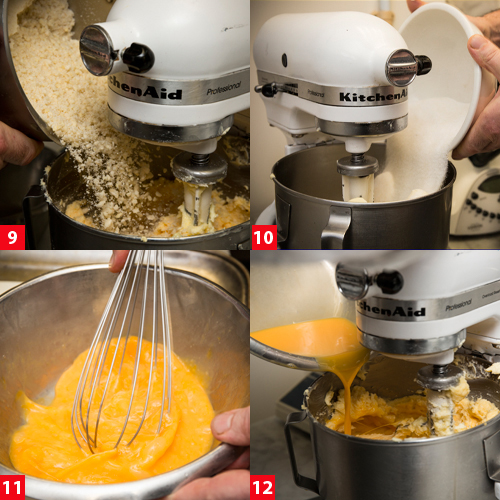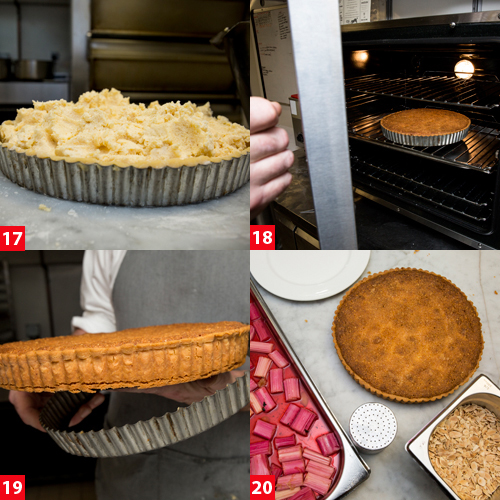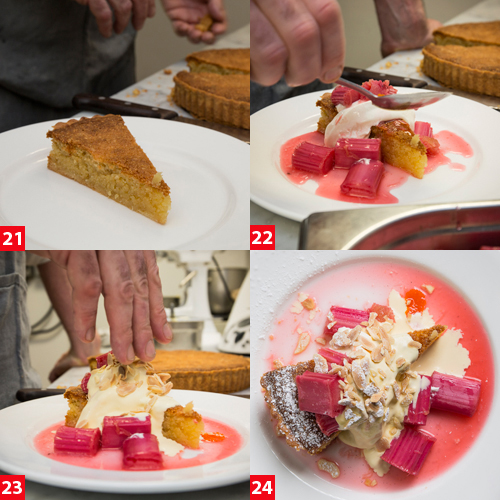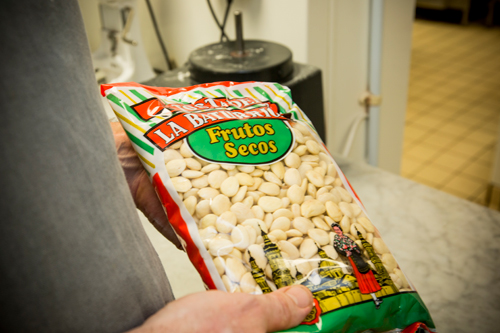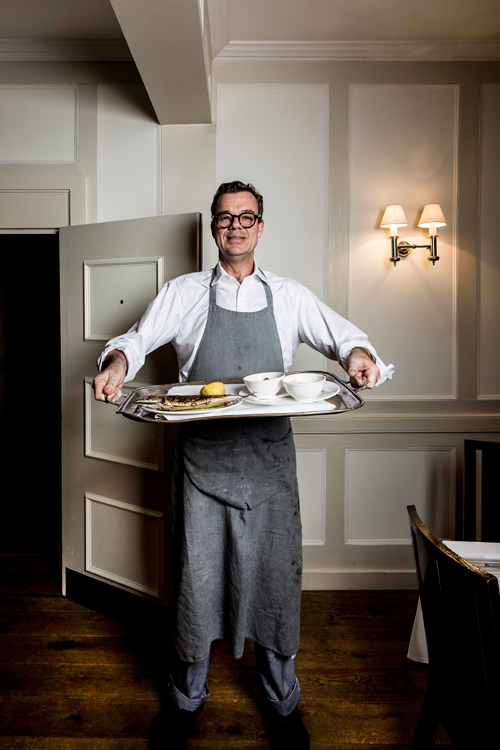Masterclass: Almond tart by Jeremy Lee of Quo Vadis
Jeremy Lee loves seeing the grins on faces when he suggests almond tart. Michael Raffael explains the Quo Vadis recipe
Almond tart (aka tarte à la frangipane) has a murky past. Many food historians link the name to a 16th-century Italian called Marquis Pompeo Frangipani living in Paris. He came up with a perfume for scenting gloves that included an extract of bitter almonds. The trail then goes cold for 100 years, until a kind of custard called ‘franchipane' appears in a French cookery book.
Tack into the next century and a version of this has found its way into the repertoire of confectionary making. By the time Escoffier's Le Guide Culinaire had appeared, it had evolved into a thick crème mixed with crushed almond macaroons.
At Quo Vadis, Jeremy Lee's frangipane-based almond tart is the latest step in the saga. His recipe has close ties to the past in that he grinds Spanish Marcona almonds. By halving the amount of sugar, he has made a filling with a lighter texture that's not too sweet.
Cost
Quo Vadis charges £9.50 for its almond tart. The almond tart itself costs about £10 to make for between 12 and 14 portions. The accompaniments (fruit compôtes, cream, flaked almonds and sometimes ice-cream) will roughly double the cost per portion. Gross profit is approximately 85%.
Planning
Make the pastry and the almond frangipane at least a day before baking. The usual batch size is based around 1kg of sugar paste to yield three, 28cm x 4cm tarts and multiples of frangipane based on 1kg almonds per tart. The fruit accompaniment varies with the season or the market.
Pastry
For 3 x 28cm x 4cm tarts
- 500g 00 flour
- 300g unsalted French butter
- 150g icing sugar, sifted
- 1 Burford Brown egg and two yolks, beaten
- Splash of water (about 1tbsp)
Put the flour and butter in a blender (1) and blend to a fine crumb. Add the icing sugar and the egg (2). Blend again until the dough starts to come together. Add a small splash of cold water and blend again.
Take the dough, now in coarse lumps, out of the machine. Knead it quickly to form a smooth dough (3). Roll it by hand on the work surface to form a cylindrical 'loaf' that's about 10cm in diameter (4). Divide into three pieces (5) and wrap in film (6). Chill until needed, but remove each piece from the fridge and allow it to reach the ambient [cool] pÁ¢tisserie temperature before rolling.
Frangipane
For 1 tart
- 1kg blanched Marcona almonds
- 1kg unsalted French butter
- 500g Billington's golden caster sugar
- 8 Burford Brown eggs at room temperature
Pour the almonds into the food processor (7) and blend. The texture has to be slightly crumbly, rather than the powdery texture of commercial ground almonds (8).
Transfer to a mixing bowl (9) and add the butter in lumps and then the sugar (10). Beat slowly using the beater attachment and then increase the speed until the ingredients are properly mixed. Beat the eggs with a whisk until the yolks and whites have combined (11).
While still beating the creamed almonds and butter at a slow speed, incorporate the egg as though making mayonnaise, ie a little at a time (12). Scrape the mixture from the edges of the bowl every so often to reduce the risk of the mixture curdling. Chill the mixture (13) overnight.
Lining the tart and baking
The pastry isn't stretchy, so there is no need to bake it blind. It is important, however, that the frangipane is chilled.
A nicely seasoned 28cm x 4cm tart ring won't need greasing.
Dust a cold, preferably marble work surface with a minimum of flour. Roll out 350g pastry to line the ring (14). Work quickly without pressing down on it. Turn the paste through about 30° with each pass of the rolling pin and be careful not to roll over the edges.
Slip the dough into place in the tart ring. Check that it fits flush against the sides and that there are no bevelled edges. Trim the top (there shouldn't be much to trim). To get a better finish, knock up the top edge of the pastry using thumb and forefinger (15).
Fill the raw pastry case with frangipane (16). To do this, spoon large lumps of it over the base. Don't try and flatten it because it will settle of its own accord during baking (17).
Transfer, straight away, to a fan-assisted oven preheated to 160°C. Stand it on a rack, but put a tray on the rack below it - butter and oil will spill onto this during cooking.
Cooking time will vary according to the oven. Start checking after 45 minutes using a skewer or knife point poked into the tart - it should come out dry (18).
Leave the tart to cool before turning out of the tart ring (19).
Quo Vadis almond tart with poached rhubarb and cream
Serves 1
- 1 slice of tart, about 100g
- 20g whipped cream
- 1 heaped dsp clotted cream
- 40g (approximate) poached forced rhubarb
- 10g (approximate) toasted flaked almonds
- Icing sugar
To serve the tart (20), put it in the centre of a medium-sized plate (21). Spoon the whipped cream over it and then the clotted cream on top of that (22). Spoon the rhubarb around the tart. Sprinkle the flaked almonds over the creams (23). Dust with icing sugar and serve (24).
Marcona almonds
These blanched Spanish almonds are plumper than those from California. Their taste is quite sweet but with a touch of bitterness. The best quality is expensive: upwards of £18 per kg. Jeremy Lee buys 1kg packets of Tostadero la Baturrica, costing £27.50 retail, from Spanish food specialist Brindisa.
Variations
Using the same proportions of toasted hazelnuts, it's possible to make a hazelnut or cobnut tart.
Alternatively, it would be possible to combine almonds with a proportion of raw pistachios.
The frangipane story
The history of frangipane goes back to the early 18th century, though French and Italian cooks dispute its origin.
Until recently, the basic recipe was much sweeter than Jeremy Lee's version. For instance, a professional textbook - Patisserie by LJ Hanneman - describes 'best quality' as 120g caster sugar, 120g butter or margarine, 120g eggs, 120g ground almonds and 8g flour.
Accompaniments
The fruit compôte accompaniment here is rhubarb poached with orange, lemon and stem ginger, but this can be switched according to the season. On the Quo Vadis menu in January, the tart came with vanilla ice-cream and poached Passe Crassane pears. In autumn the kitchen has switched to elderberries and in early summer to cherries.
Tips
- You can prepare the tart in advance and freeze it overnight for baking the next day
- Avoid over-grinding the almonds or the tart will have a dense texture
- Make the pastry and the frangipane as part of the same mise en place
- Skimping on any of the raw materials will affect the texture of the tart
- Jeremy Lee prefers French butter because it is less creamy than most British butter
- Don't try and prettify the presentation - it's meant to look scrumptious rather than geometric
Quo Vadis's kipper breakfast omelette
A central part of Jeremy Lee's success at Quo Vadis has been the imaginative breakfast dishes.
Serves 1
- 2 rashers of streaky bacon
- 1tbs diced onion, sweated
- 1 kipper
- 120ml whipping cream
- 3 Burford Brown eggs
- 1tbs chopped parsley
- 30g butter
- Salt
Roughly dice the bacon and fry until crisp. Combine it with the onion.
Grill the kipper under the salamander with the skin towards the heat. Remove the skin and bones. Roughly flake the flesh.
Beat the cream and eggs together. Add the parsley and a little salt.
Heat the butter in a 20cm cast-iron pan. Pour in the egg and let the crust form on the bottom of the omelette.
Transfer to a hot oven and allow the top of the omelette to set. Turn out onto the plate like a Spanish tortilla.
Jeremy Lee
According to Quo Vadis supremo Jeremy Lee, Prue Leith described his cooking on Great British Menu as being like "some clever granny's". He recognised how perceptive her comment was: "It tickled me pink."
His style reflects a fusion between home cooking crafted at the highest level and the professional roots he put down while working for Simon Hopkinson at Bibendum and for Alastair Little. "I've never worked in a kitchen," he recalled, "where chefs were abused. I've been terribly lucky."
That unflustered approach has meant that his intuitive sense of what good food should taste like has never been dampened. Instead of following fashions or trends, he has honed his skills, which resulted in him winning the 2012 Menu of the Year Catey, sponsored by Quorn.
Through a career spanning the nouvelle cuisine, modern British and molecular cuisine eras, he has trusted what he knows best - his palate. He admitted that technology and presentation matter less to him than the fine detail of choosing ingredients that influence taste: "I like food that is complete, that falls on the plate as nature intended; a lovely tumble of good things."
He has a special affection for desserts and pastry: "All my favourite cooks love puddings. Suggest profiteroles, a rum baba or a great almond tart or meringue, and everyone's face lights up with a huge grin and you know you've hit the jackpot. If people who think they are stuffed find room for a pudding, you know you've done a good job."
Continue reading
You need to be a premium member to view this. Subscribe from just 99p per week.
Already subscribed? Log In





